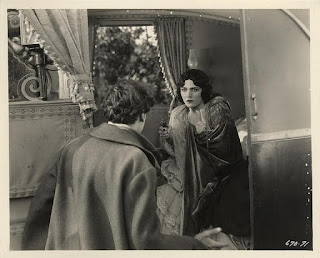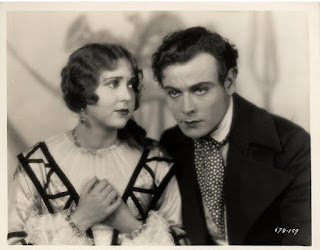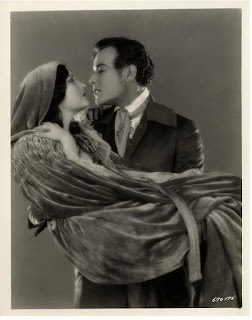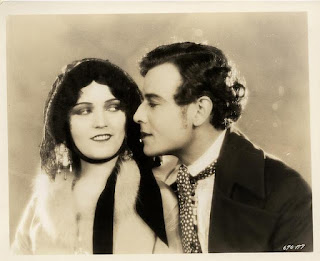Loves of an Actress, 1928, starring Pola Negri, Nils Asther and Mary McAllister is a a lost film - all surviving prints are gone and with it, the plot, except what can be gleaned from promotional stills, cinema posters and contemporary reviews.
By 1928, when it was made, the era of silent pictures was coming to an end. Loves of an Actress did not have what we we would nowadays call a soundtrack - instead smatterings of sound effects were played at certain moments, like a baby's cry or animal noises.
Pola Negri's latest offering seems to prove that there is, after all, a day of atonement for the errors of youth. Unfortunately, however, "Loves of an Actress," despite the enchantment of the plural, can be called only another motion picture.
The background or the play is France in the middle of the last century. Miss Negri takes the part of an actress who has risen to being the toast of Paris—risen chiefly through her affairs with three important gentlemen—a banker, a newspaper owner and a count.
It inevitably happens that at the height of her career she falls in love with a young man who is soon to become an Ambassador to Russia. Two of her former gentlemen friends grin and bear it; the third states sullenly that he loves her still. To prove it, he threatens to publish her letters in the columns which previously had been devoted to praising her acting.
The actress, Rachel, first of all dares him to go ahead, but on sober second thought she realizes that not only will that be the end of her career but it will ruin her fiancé's as well. She breaks the engagement. Not long afterward she dies of a broken heart—first, however, playing a death scene in such a manner as to wring the greatest praise from her public.
The chief trouble with "Loves of an Actress" is that it is too long. The story is not new, and as there is no suspense it all comes down to a question of waiting for the expected to happen. And then it develops so slowly as to be a little tiresome.
There are scenes scattered here and there, however, which show Miss Negri's acting ability to good advantage. She gives a good portrait of an actress—if not necessarily of midnineteenth century France—and her relationships with her several admirers are well done. Nils Asther, as Raoul—the man she loves—cannot quite curb a tendency to overact his part; otherwise the supporting cast is acceptable.
"Loves of an Actress" demonstrates ad absurdam the potentialities of synchnorization. The varied noises taking part in the action of the picture range from the squealing effect when a baby is shown crying through sundry barnyard effects early one morning to vocal selections. An orchestra in the pit would have been better.
On the stage there is Paul Ash and the Paramount Orchestra exploiting Broadway. They are assisted by Fred Bernard, Helen Honan, the Collette Sisters, Sally Starr, Du Calion and some Gamby-Hale Girls.
Music score for the film's hit song, Sunbeams (bring dreams of you)
Promotional stills for the film
Mary McAllister and Nils Asther
 |
| Pola Negri and Nils Asther |
Cigarette cards promoting the film - these were included in packs by tobacco companies

































































